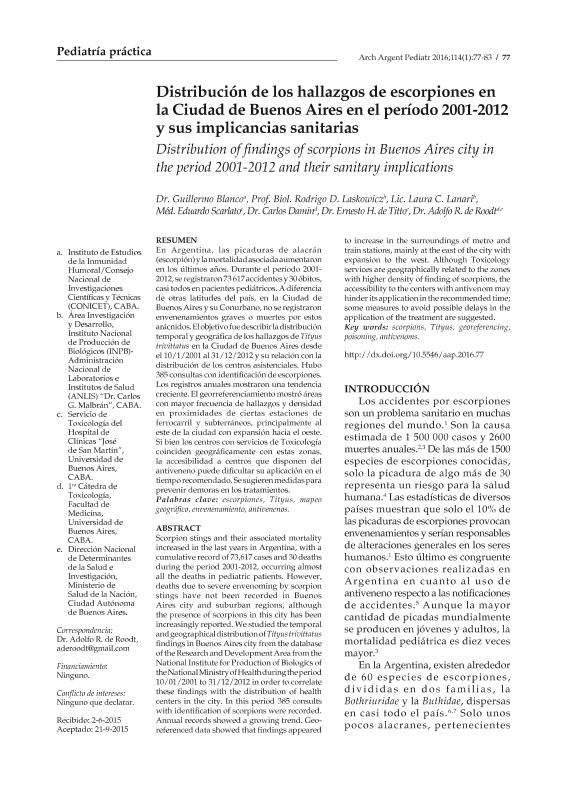Artículo
En Argentina, las picaduras de alacrán (escorpión) y la mortalidad asociada aumentaron en los últimos años. Durante el período 20012012, se registraron 73 617 accidentes y 30 óbitos, casi todos en pacientes pediátricos. A diferencia de otras latitudes del país, en la Ciudad de Buenos Aires y su Conurbano, no se registraron envenenamientos graves o muertes por estos arácnidos. El objetivo fue describir la distribución temporal y geográfica de los hallazgos de Tityus trivittatus en la Ciudad de Buenos Aires desde el 10/1/2001 al 31/12/2012 y su relación con la distribución de los centros asistenciales. Hubo 385 consultas con identificación de escorpiones. Los registros anuales mostraron una tendencia creciente. El georreferenciamiento mostró áreas con mayor frecuencia de hallazgos y densidad en proximidades de ciertas estaciones de ferrocarril y subterráneos, principalmente al este de la ciudad con expansión hacia el oeste. Si bien los centros con servicios de Toxicología coinciden geográficamente con estas zonas, la accesibilidad a centros que disponen del antiveneno puede dificultar su aplicación en el tiempo recomendado. Se sugieren medidas para prevenir demoras en los tratamientos. Scorpion stings and their associated mortality increased in the last years in Argentina, with a cumulative record of 73,617 cases and 30 deaths during the period 2001-2012, occurring almost all the deaths in pediatric patients. However, deaths due to severe envenoming by scorpion stings have not been recorded in Buenos Aires city and suburban regions, although the presence of scorpions in this city has been increasingly reported. We studied the temporal and geographical distribution of Tityus trivittatus findings in Buenos Aires city from the database of the Research and Development Area from the National Institute for Production of Biologics of the National Ministry of Health during the period 10/01/2001 to 31/12/2012 in order to correlate these findings with the distribution of health centers in the city. In this period 385 consults with identification of scorpions were recorded. Annual records showed a growing trend. Geo-referenced data showed that findings appeared to increase in the surroundings of metro and train stations, mainly at the east of the city with expansion to the west. Although Toxicology services are geographically related to the zones with higher density of finding of scorpions, the accessibility to the centers with antivenom may hinder its application in the recommended time; some measures to avoid possible delays in the application of the treatment are suggested.
Distribución de los hallazgos de escorpiones en la Ciudad de Buenos Aires en el período 2001-2012 y sus implicancias sanitarias
Título:
Distribution of findings of scorpions in Buenos Aires city in the period 2001-2012 and their sanitary implications
Blanco, Guillermo Armando C. ; Laskowicz, Rodrigo D.; Lanari, Laura C.; Scarlatto, Eduardo; Damin, Carlos Fabian; de Titto, Ernesto Horacio
; Laskowicz, Rodrigo D.; Lanari, Laura C.; Scarlatto, Eduardo; Damin, Carlos Fabian; de Titto, Ernesto Horacio ; de Roodt, Adolfo Rafael
; de Roodt, Adolfo Rafael
 ; Laskowicz, Rodrigo D.; Lanari, Laura C.; Scarlatto, Eduardo; Damin, Carlos Fabian; de Titto, Ernesto Horacio
; Laskowicz, Rodrigo D.; Lanari, Laura C.; Scarlatto, Eduardo; Damin, Carlos Fabian; de Titto, Ernesto Horacio ; de Roodt, Adolfo Rafael
; de Roodt, Adolfo Rafael
Fecha de publicación:
02/2016
Editorial:
Sociedad Argentina de Pediatría
Revista:
Archivos Argentinos de Pediatría
ISSN:
0325-0075
e-ISSN:
1668-3501
Idioma:
Español
Tipo de recurso:
Artículo publicado
Clasificación temática:
Resumen
Palabras clave:
Escorpiones
,
Tityus
,
Mapeo Geográfico
,
Envenenamiento
,
Antivenenos
Archivos asociados
Licencia
Identificadores
Colecciones
Articulos(IDEHU)
Articulos de INST.DE EST.DE LA INMUNIDAD HUMORAL PROF.R.A.MARGNI
Articulos de INST.DE EST.DE LA INMUNIDAD HUMORAL PROF.R.A.MARGNI
Citación
Blanco, Guillermo Armando C.; Laskowicz, Rodrigo D.; Lanari, Laura C.; Scarlatto, Eduardo; Damin, Carlos Fabian; et al.; Distribución de los hallazgos de escorpiones en la Ciudad de Buenos Aires en el período 2001-2012 y sus implicancias sanitarias
; Sociedad Argentina de Pediatría; Archivos Argentinos de Pediatría; 114; 1; 2-2016; 77-83
Compartir
Altmétricas



